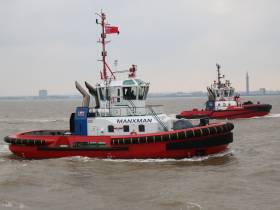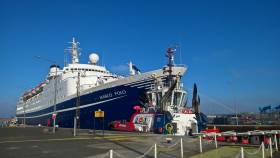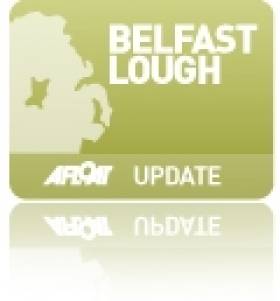Displaying items by tag: SMS Towage
#ports&shipping - A towage firm in the UK which includes operations in Belfast, has expanded its fleet with a new tug making a recent arrival onto the Humber estuary that leads to the North Sea, writes Jehan Ashmore.
The new tug Manxman operated by SMS Towage of Hessle, north Yorkshire, now brings the Humber based fleet up to 10 vessels and this represents around £5 million worth of investment.
According to SMS, the Azimuth Stern Drive (ASD) 2411 tug is capable of 4200 BKW and sports a bollard pull of 72 tonnes. A brake horsepower of 5,600 is achieved and the tug offers more power than seven Ferraris.
The arrival of the Damen built tug in the Netherlands has been welcomed by the Associated British Port group. Among its portfolio, ABP operates the ports of Goole, Grimsby, Hull and Immingham. These ports are located on both sides of the estuary which is formed by the confluence of the tidal rivers Ouse and Trent.
As reported last year, Afloat saw the former Belfast based Irishman operate out of the Port of Hull. On that occasion the 40 tonnes bollard pull tug was assisting cruiseship Marco Polo through a dock lock prior to setting a course bound for Harwich in Essex.
In addition to operations at the North Sea port and in Northern Ireland, SMS also have tugs located in south-east Wales and in Portsmouth, England.
#Ports&Shipping - A former Belfast Port based tug, Irishman is currently to be found busy working in the East Yorkshire port of Hull on the Humber Estuary that flows into the North Sea, writes Jehan Ashmore.
Irishman, a 40 ton bollard pull tug had served in the original fleetline up stationed in Belfast Harbour, when Yorkshire based company SMS Towage located in Hessle, upriver of Hull, entered the towage market on the River Lagan from 2013. The 50 bollard pull tug Masterman, which started work in the city also that year was joined by sister Merchantman in 2015.
Merchantman in recent weeks assisted in the neighbouring Port of Larne. This involved handling the longest ever ship to the port, tanker CPO Germany which called to the ferryport (P&O services to Cairnryan) for scheduled maintenance.
In addition to Northern Ireland, SMS Towage which has an all (ASD) Azimuth Stern Drive designed fleet totalling 16 tugs, has operations spread throughout the UK, at ports on the Bristol Channel, Portsmouth in Hampshire and asides Hull, the towage firm has fleets elsewhere on the Humber estuary. These operations are at the Ports of Goole, Grimsby and Immingham (see major investment plans at the UK's Biggest Port). The port trio is operated by Associated British Ports (ABP).
Afloat recalls the first occasion of setting sight on Irishman, when in the summer boarding Cruise & Maritime Voyages (CMV) veteran Marco Polo berthed in Hull's King George V Dock. The 24m Irishman had berthed ahead of the sweeping gracefull classic hull lines of former Soviet liner Aleksandr Pushkin launched in 1965 in the then Eastern Bloc state of East Germany.
These liner voyages ran between Leningrad, Russia and Montreal and Quebec in Canada, and also en-route calls via Tilbury, London, coincidently CMV's main UK homeport. (See further below, current cruise to Canada).
When Marco Polo eased of the berth in Hull's King George V Dock (used by P&O Ferries services to Belgium and Netherlands), the Irishman assisted at the bow of the 20,080 gross tonnage cruiseship. Also in the North Sea port was the aptly named Yorkshireman that handled operations at the ship's 'cruiser' stern. It is from here overlooking the stern that cruise-goers thronged the outside tiered decks to lap up the summer's notably prolonged heatwave and experience transitting the dock's lock.
Powered by twin Niigata engines at 3,000 bhp, Irishman lead Marco Polo through the dock's entrance. When Marco Polo eventually vacated the dock into the open waters of the Humber Estuary, mooring lines were handled by the cruiseship crew and those of the tugs in advance to the start of a one-night coastal mini cruise to Harwich, Essex.
As previously reported on Afloat, Marco Polo is also pictured in same Hull dock during another cruise accompanied by SMS new Superman which boasts a 72 ton bollard pull capability. The newcomer joins fleetmates, among them Englishman, Welshman and Scotsman.
Marco Polo as previously reported operates cruises to Ireland based from Hull, in addition the port has attracted other operators. This week on Thursday at Tilbury, is from where the cruiseship departed the Thames Estuary on a trans-Atlantic cruise. The first leg involved an overnight passage to Ireland, where the 880 adults-only cruiseship made an arrival yesterday to the scenic surroundings off Glengariff. The Bahamas flagged took anchorage in Bantry Bay.
The cruisecall to the west Cork destination, is where Bantry Bay Port Company is responsible for such ships visiting (but otherwise tanker traffic dominates). A further two cruise callers are scheduled this month marking the end of this year's season.
Today, Marco Polo continues heading further into the Altantic Ocean and bound for St. John's, Newfoundland, Canada, where the aforementioned former liner spent a career in the early years. The cruiseship is due to make landfall on 12 September followed by calls including Montreal and Québec City.
#CruiseLiners - The deep blue-hulled Marco Polo, Cruise & Maritime Voyages veteran vessel as Afloat previously featured calling to Irish ports is among seven cruiseships that will use the UK Port of Hull this season, writes Jehan Ashmore.
The North Sea port located on the Humber estuary is operated by Associated British Ports (ABP) and has become an increasingly popular cruise calling destination and for those directly departing from the port in East Yorkshire. In order to further attract cruise-goers, ABP has invested in creating additional car parking for holidaymakers to ensure a stress-free trip embarking.
Marco Polo has called to the Port of Hull throughout the summer and Afloat will have more to report on a mini-cruise between Hull and Harwich in Essex.
In addition to CMV's Marco Polo, the first caller this season to Port of Hull was Silversea Cruises six-star expedition ship, Silver Cloud. The 250 passengers enjoyed a day trip to Hull, last year's UK City of Culture and to nearby historically-steeped York.
According to ABP, port apprentices and staff lined up to welcome the Silver Cloud passengers to Hull as they enjoyed canapés and jazz music prior to boarding. Also taking place was a traditional plaque exchange held on board between ABP, Silver Cloud’s Captain and Hull City Council’s Lord Mayor and Admiral of the Humber.
The 12 day Silversea Cruise toured the UK which concluded in the Pool of London where the 157m entered through the iconic Tower Bridge. Also this season, passengers boarded Silver Cloud from this central location on a cruise to include Ireland's Wild Atlantic Way.
Hull is centrally located port on the Humber and is already home to daily P&O Ferries operated routes to Zeebrugge and Rotterdam. Together these overnight services annually handle just under one million passengers travelling to Belgium and The Netherlands.
#WorkboatSafety - SMS Towage which has towage operations in Belfast Harbour is spearheading an industry drive to create a new national workboat safety standard across the UK.
The Hessle-based business expanded its towage operations to Belfast in 2013 as previously reported on Afloat.ie, is to help implement the Maritime Coastguard Agency (MCA) -approved Voluntary Towage Endorsement Scheme with the National Workboat Association (NWA).
It has started to rollout the new scheme that leads to a recognised ship assist qualification meeting the strict standards of the Port Marine Safety Code.
Patrick Lyon, managing director of SMS Towage, said: "We need to continually push to ensure the safe operation of vessels. This scheme is being introduced now and will create a new standard of training for workboat safety".
"We already have excellent safety training systems but have been working to achieve a unified scheme that benefits crew, customers and the industry as a whole. We are supporting this every inch of the way."
Hugh Patience, SMS's marine manager and a qualified assessor, is on the NWA's training sub-committee and has produced manuals to help association members get up to speed with the scheme.
"Hugh is an expert safety training assessor," said Mr Lyon. "He is one of the most experienced in the industry and has been instrumental in getting this voluntary scheme off the ground.
Hugh added: "It has been well received and we expect it to become industry standard."
"All of our skippers are already going through the training, and the process of implementing the new standard has started in the Humber, Belfast and South Wales Ports where SMS Towage operates."































































